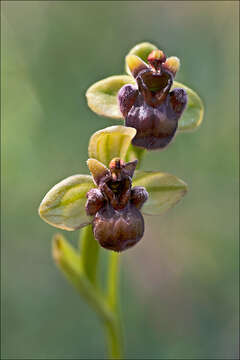Ophrys-bombyliflora_1

Description:
Ophrys bombyliflora Link, syn.: Arachnites bombyliflorus (Link) Tod., Ophrys tabanifera Willd., Ophrys distoma Biv., Ophrys hiulca Mauri, Ophrys canaliculata Viv., Ophrys labrofossa Brot.Family: Orchidaceae JussBumble Bee Orchid, Bumblebee Orchid, DE: Drohnen-Ragwurz; CR: svilena cvjetna kokica, kokoicaSlo.: ?Dat.: May 17. 2012Lat.: 44.78797 Long.: 13.91256Code: Bot_618/2012_DSC3437Habitat: Dry, stony grassland with some bushes, light wood edge; sandy, skeletal soil; almost flat terrain, partly sunny; average temperatures 13-14 deg C, average precipitation 800-900 mm/year, elevation 15 m (50 feet), Sub-Mediterranean phytogeographical region.Substratum: soil.Place: Cape Kamenjak National park, next to the main dirt road leading to the far south tip of the peninsula, about 1.5 km south of Premantura; Istria, Croatia EC.Comment: Ophrys bombyliflora is one of a few bee orchids (Ophrys), which, unlike most of the other species of Ophrys, is easy to recognize reliably. This is due to two facts: first, it exhibits minimum plasticity in its morphology. Growing mostly in Mediterranean region from Canary Islands and Portugal on the west to Turkey on the east, its flowers have almost the same shape and colors everywhere. Secondly, it is morphologically quite far from the closest similar Ophrys species. Small plant, rarely more than 20 cm tall, which flowers are not so picturesque as of most other bee orchids, has quite special shape of flowers, easy to remember.As a true Mediterranean plant it doesn't grow in Slovenia. But one can find it in neighboring Croatia. It is quite common on dry grassland and garrigue on the south tip of Istria peninsula around Pula region, including cape Kamenjak national park.Protected in Croatia and marked as a vulnerable species (VU). Protected by The Convention on International Trade in Endangered Species of Wild Fauna and Flora CITES.Ref.:(1) www.orchidsofbritainandeuropetest.uk/Ophrys%20bombyliflor... (accessed March 12. 2019)(2) H. Baumann, S. Kuenkele, R.Lorenz, Orchideen Europas, Ulmer (2006), p 146.(3) I. Schnfelder, P. Schnfelder, Kosmos Atlas Mittelmeer- und Kanarenflora, Kosmos, (2002), p 292.(4) M. Blamey, C. Grey-Wilson, Wild Flowers of the Mediterranean, A & C Black, London (2005), p 520.
Included On The Following Pages:
- Life (creatures)
- Cellular (cellular organisms)
- Eukaryota (eukaryotes)
- Archaeplastida (plants)
- Chloroplastida (green plants)
- Streptophyta
- Embryophytes
- Tracheophyta (ferns)
- Spermatophytes (seed plants)
- Angiosperms (Dicotyledons)
- Monocots (Monocotyledons)
- Asparagales
- Orchidaceae (orchids)
- Ophrys (ophrys)
- Ophrys bombyliflora (Bumblebee orchid)
This image is not featured in any collections.
Source Information
- license
- cc-by-nc-sa
- copyright
- Amadej Trnkoczy
- photographer
- Amadej Trnkoczy
- original
- original media file
- visit source
- partner site
- Flickr Group
- ID


